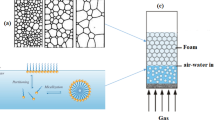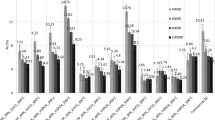Abstract
Saponins from various botanical origins highly differ in molecular structure. Little is known of the influence of structural differences between the different saponins on interfacial tension, short-term adsorption and foam properties at the air-water interface (a/w). In this study five triterpenoid saponins, with three of these being monodesmosidic and two bidesmosidic as well as one steroid saponin, were analyzed. Interfacial tension isotherms were measured using a tensiometer with a Wilhelmy plate and were fitted using the modified Frumkin model. For characterization of the short-term adsorption at the a/w-interface, two-fluid needle experiments were performed. Foaming, foam stability and foam structure were analyzed using a foaming device. A new method for semi-quantitative analysis of different foam structures was established. Additionally the impact of pH and ionic strength (addition of NaCl) on interfacial tension and foam properties were determined. The short-term adsorption of all saponins was limited by an additional barrier and was not diffusion-limited. Extracts from Quillaja saponaria Molina (QS), Gypsophila (GYP), Camellia oleifera Abel (TS) and Aesculus hippocastanum (ESC) lowered the interfacial tension to 37–42 mN/m and produced stable foams. The steroid saponin from Tribulus terrestris (TT) and the monodesmosidic saponin from Glycyrrhiza glabra (GA) had only poor interfacial and foam properties. Foams made from QS and GYP were only little affected by changes in pH and ionic strength. A reduction of the pH from 5 to 3 increased stability of foams made from GA significantly. Foams made from ESC and TS were negatively affected by increasing ionic strength.




Similar content being viewed by others
References
I. Raskin, D.M. Ribnicky, S. Komarnytsky, N. Ilic, A. Poulev, N. Borisjuk, A. Brinker, D.A. Moreno, C. Ripoll, N. Yakoby, J.M. O’Neal, T. Cornwell, I. Pastor, B. Fridlender, Plants and human health in the twenty-first century. Trends Biotechnol. 20, 522–531 (2002)
E. Pojer, F. Mattivi, D. Johnson, C.S. Stockley, The case for anthocyanin consumption to promote human health: a review. Comprehensive Reviews in Food Science and Food Safety 12, 483–508 (2013)
H. Schroeter, C. Heiss, J.P. Spencer, C.L. Keen, J.R. Lupton, H.H. Schmitz, Recommending flavanols and procyanidins for cardiovascular health: current knowledge and future needs. Mol. Asp. Med. 31, 546–557 (2010)
S.G. Sparg, M.E. Light, J. van Staden, Biological activities and distribution of plant saponins. J. Ethnopharmacol. 94, 219–243 (2004)
K. Haralampidis, M. Trojanowska, A.E. Osbourn, Biosynthesis of triterpenoid saponins in plants. Adv. Biochem. Eng. Biotechnol. 75, 31–49 (2002)
J.-P. Vincken, L. Heng, A. de Groot, H. Gruppen, Saponins, classification and occurrence in the plant kingdom. Phytochemistry 68, 275–297 (2007)
B. Dinda, S. Debnath, B.C. Mohanta, Y. Harigaya, Naturally occurring triterpenoid saponins. Chem. Biodivers. 7, 2327–2580 (2010)
W. Oleszek, Z. Bialy, Chromatographic determination of plant saponins—an update (2002–2005). J. Chromatogr. A 1112, 78–91 (2006)
S. Yao, J. Luo, X. Huang, L. Kong, Application of preparative high-speed counter-current chromatography/preparative high-performance liquid chromatography mode in rapid separation of saponins. J. Chromatogr. B 864, 69–77 (2008)
A. Kezwon, K. Wojciechowski, Interaction of quillaja bark saponins with food-relevant proteins. Adv. Colloid Interf. Sci., 185–195 (2014)
S. Mitra, S.R. Dungan, Micellar Properties of Quillaja Saponin. 1. Effects of Temperature, Salt, and pH on Solution Properties. J. Agric. Food Chem. 45, 1587–1595 (1997)
R. Stanimirova, K. Marinova, S. Tcholakova, N.D. Denkov, S. Stoyanov, E. Pelan, Surface rheology of saponin adsorption layers. Langmuir 27, 12486–12498 (2011)
K. Golemanov, S. Tcholakova, N. Denkov, E. Pelan, S.D. Stoyanov, Surface shear rheology of saponin adsorption layers. Langmuir 28, 12071–12084 (2012)
K. Wojciechowski, Surface activity of saponin from quillaja bark at the air/water and oil/water interfaces. Colloids Surf. B: Biointerfaces 108, 95–102 (2013)
Y. Yang, M.E. Leser, A.A. Sher, D.J. McClements, Formation and stability of emulsions using a natural small molecule surfactant: quillaja saponin (Q-naturale®). Food Hydrocoll. 30, 589–596 (2013)
K. Golemanov, S. Tcholakova, N. Denkov, E. Pelan, S.D. Stoyanov, Remarkably high surface visco-elasticity of adsorption layers of triterpenoid saponins. Soft Matter 9, 5738–5752 (2013)
K. Wojciechowski, M. Piotrowski, W. Popielarz, T.R. Sosnowski, Short- and mid-term adsorption behaviour of quillaja bark saponin and its mixtures with lysozyme. Food Hydrocoll. 25, 687–693 (2011)
M. Piotrowski, J. Lewandowska, K. Wojciechowski, Biosurfactant–protein mixtures: quillaja bark saponin at water/air and water/oil interfaces in presence of β-lactoglobulin. J. Phys. Chem. B 116, 4843–4850 (2012)
Y.-F. Chen, C.-H. Yang, M.-S. Chang, Y.-P. Ciou, Y.-C. Huang, Foam properties and detergent abilities of the saponins from camellia oleifera, Ijms 11 (2010) 4417–4425.
J. Bankefors, L.I. Nord, L. Kenne, Structural classification of quillaja saponins by electrospray ionization ion trap multiple-stage mass spectrometry in combination with multivariate analysis, proof of concept. Chemom. Intell. Lab. Syst. 90, 178–187 (2008)
B. Thalhamer, M. Himmelsbach, Characterization of quillaja bark extracts and evaluation of their purity using liquid chromatography–high resolution mass spectrometry. Phytochem. Lett. 8, 97–100 (2014)
D. Frechet, B. Christ, du sorbier, Bertrand monegier, H. Fischer, M. Vuilhorgne, four triterpenoid saponins from dried roots of gypsophila species. Phytochemistry 30, 927–931 (1991)
Q. Chen, J.-G. Luo, L.-Y. Kong, New triterpenoid saponins from the roots of gypsophila perfoliata Linn. Carbohydr. Res. 346, 2206–2212 (2011)
S. Yao, J.-G. Luo, L. Ma, L.-Y. Kong, Two new triterpenoid saponins from the roots of gypsophila paniculata with potent α-glucosidase inhibition activity. Chinese Journal of Natural Medicines 9, 401–405 (2011)
L. Voutquenne-Nazabadioko, R. Gevrenova, N. Borie, D. Harakat, C. Sayagh, A. Weng, M. Thakur, M. Zaharieva, M. Henry, Triterpenoid saponins from the roots of gypsophila trichotoma wender. Phytochemistry 90, 114–127 (2013)
D. Pertuit, S. Avunduk, A.-C. Mitaine-Offer, T. Miyamoto, C. Tanaka, T. Paululat, S. Delemasure, P. Dutartre, M.-A. Lacaille-Dubois, Triterpenoid saponins from the roots of two gypsophila species. Phytochemistry 102, 182–188 (2014)
P.-C. Kuo, T.-C. Lin, C.-W. Yang, C.-L. Lin, G.-F. Chen, J.-W. Huang, Bioactive saponin from tea seed pomace with inhibitory effects against Rhizoctonia solani. J. Agric. Food Chem. 58, 8618–8622 (2010)
Q. Huang, M. He, H. Chen, L. Shao, D. Liu, Y. Luo, Y. Dai, Protective effects of sasanquasaponin on injury of endothelial cells induced by anoxia and reoxygenation in vitro. Basic Clin. Pharmacol. Toxicol. 101, 301–308 (2007)
X.-F. Zhang, Y.-Y. Han, G.-H. Bao, T.-J. Ling, L. Zhang, L.-P. Gao, T. Xia, A new saponin from tea seed pomace (camellia oleifera Abel) and its protective effect on PC12 cells. Molecules 17, 11721–11728 (2012)
H. Zhou, C.Z. Wang, J.Z. Ye, H.X. Chen, New triterpene saponins from the seed cake of camellia oleifera and their cytotoxic activity. Phytochem. Lett. 8, 46–51 (2014)
G. Wulff, R. Tschesche, Über triterpene - XXVI: über die struktur der rosskastaniensaponine (aescin) und die aglykone verwandter glykoside. Tetrahedron 25, 415–436 (1969)
D. Dinchev, B. Janda, L. Evstatieva, W. Oleszek, M.R. Aslani, I. Kostova, Distribution of steroidal saponins in tribulus terrestris from different geographical regions. Phytochemistry 69, 176–186 (2008)
A.M. Khan, S.S. Shah, Determination of CMC of SDS and the effect of low concentration of pyrene on its CMC. J. Chem. Soc. Pak. 30, 186–191 (2008)
F. Tamm, G. Sauer, M. Scampicchio, S. Drusch, Pendant drop tensiometry for the evaluation of the foaming properties of milk-derived proteins. Food Hydrocoll. 27, 371–377 (2012)
A. Ward, L. Tordai, Time-dependence of boundary tensions of solutions I. The role of diffusion in time-effects. J. Chem. Phys. 14, 453 (1946)
K. Lunkenheimer, K. Malysa, K. Winsel, K. Geggel, S. Siegel, Novel method and parameters for testing and characterization of foam stability. Langmuir 26, 3883–3888 (2010)
S. Karakashev, E. Manev, A. Nguyen, Interpretation of negative values of the interaction parameter in the adsorption equation through the effects of surface layer heterogeneity. Adv. Colloid Interf. Sci. 112, 31–36 (2004)
V.L. Kolev, K.D. Danov, P.A. Kralchevsky, G. Broze, A. Mehreteab, Comparison of the van der Waals and frumkin adsorption isotherms for sodium dodecyl sulfate at various salt concentrations. Langmuir 18, 9106–9109 (2002)
V. Fainerman, E. Lucassen-Reynders, R. Miller, Adsorption of surfactants and proteins at fluid interfaces. Colloids Surf. A Physicochem. Eng. Asp. 143, 141–165 (1998)
M. Rodriguez Nino, C. Sanchez, V. Ruizhenestrosa, J. Patino, Milk and soy protein films at the air/water interface. Food Hydrocoll. 19, 417–428 (2005)
J. Feng, Y. Chen, X. Liu, S. Liu, Efficient improvement of surface activity of tea saponin through Gemini-like modification by straightforward esterification. Food Chem. 171, 272–279 (2015)
M. Almutairi, M. Ali, Direct detection of saponins in crude extracts of soapnuts by FTIR. Nat. Prod. Res. 29, 1271–1275 (2015)
P.C. Pavan, E.L. Crepaldi, de a. Gomes, gilmar, J.B. Valim, adsorption of sodium dodecylsulfate on a hydrotalcite-like compound. Effect of temperature, pH and ionic strength. Colloids Surf. A Physicochem. Eng. Asp. 154, 399–410 (1999)
G. do Canto, J. Treter, S. Yang, G. Borré, M. Peixoto, G. Ortega, Evaluation of foam properties of saponin from Ilex paraguariensis A. St. Hil. (Aquifoliaceae) fruits, Braz. J. Pharm. Sci. 46, 237–243 (2010)
Acknowledgments
The authors thank Ingredion Germany GmbH, Dr. H. Schmittmann GmbH, Changsha Nulant Chem. Co., Ltd. Xi’An Union Pharmpro Co., Ltd. for supplying saponin extracts. Special thanks to Matteo Scampicchio and Marco Mason for their assistance when performing FTIR measurements, as well as Cornelia Rauh and Daniel Baier for supporting the foam experiments. Sandra Böttcher gratefully acknowledges the financial support of the Friedrich-Naumann Foundation for Freedom.
Author information
Authors and Affiliations
Corresponding author
Electronic supplementary material
ESM 1
(DOCX 537 kb)
Rights and permissions
About this article
Cite this article
Böttcher, S., Drusch, S. Interfacial Properties of Saponin Extracts and Their Impact on Foam Characteristics. Food Biophysics 11, 91–100 (2016). https://doi.org/10.1007/s11483-015-9420-5
Received:
Accepted:
Published:
Issue Date:
DOI: https://doi.org/10.1007/s11483-015-9420-5




